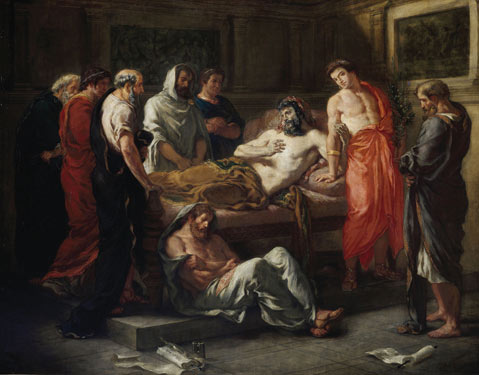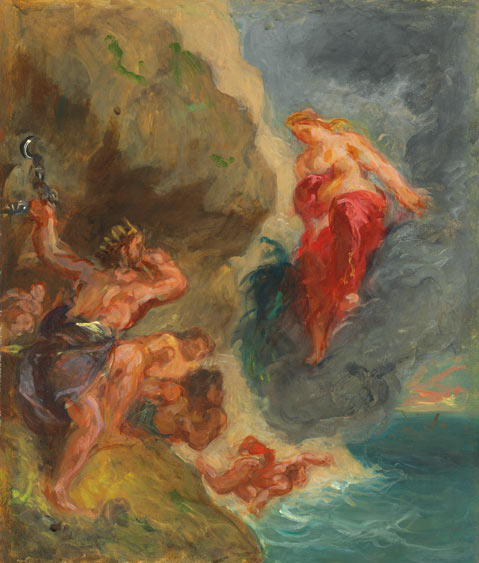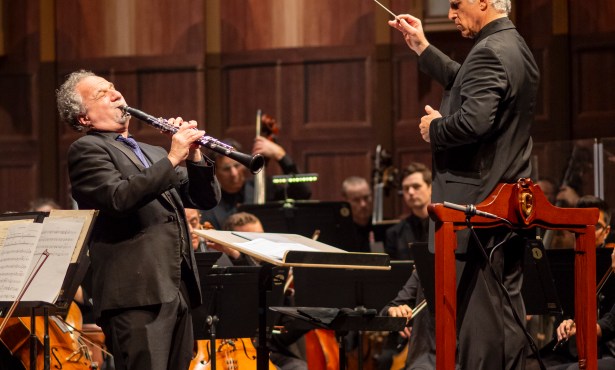Delacroix: The Painter of Modern History
Santa Barbara Museum Shows Recently Discovered Work

Call it Antiques Roadshow syndrome — people who believe they own unauthenticated masterpieces approach curators at major museums all the time in the hope that someone with some authority will finally recognize the real value of what they have. While the vast majority of such incidents are false alarms, this case was different. When the descendants of a distinguished Swiss family now living in Montecito contacted Eik Kahng, the chief curator at the Santa Barbara Museum of Art, to let her know that they had a painting in their home that they believed to be by 19th-century French master Eugène Delacroix, she was interested enough to ask for some image files. What she saw on her computer screen surprised her. “Most families don’t normally have a painting of a dead guy in a bed,” she told me, giving the subject of the picture in question, “The Last Words of Marcus Aurelius,” its most blunt possible construction. As she looked over the rest of the items in the estate known as the Van Asch van Wyck Trust, Kahng was struck by the relative coherence of what she saw.

“There were paintings by obscure French painters such as Cherubino Pata, a follower of Courbet, and antique clocks by famous Swiss clockmakers. It was the kind of family collection you would expect to find in a château in Neuchâtel — except it was in Montecito,” said Kahng.
Although its early provenance was unclear, the unsigned painting supposed to be by Delacroix had been in the family for generations, and the more Kahng looked at it — in person now, not as a JPEG — the more certain she became that it was genuine. In the absence of the dean of Delacroix scholars, Lee Johnson, who died in 2006, Kahng turned to the forensic resources of conservators, who determined that, at least as far as the materials used were concerned, the painting checked out. The next step was to begin showing it to the community of scholars who might be in a position to authenticate such a painting, and now, after several months of intensive research, the case of the Montecito Delacroix is being turned over to the public in a marvelous new exhibition called Delacroix and the Matter of Finish, which will be on view at the SBMA through January 26, 2014.
For Kahng, the multifaceted scholar charged with reshaping the SBMA’s overall approach to exhibiting the art of the past, the newfound Delacroix was much more than an individual windfall, and through her careful planning of the current show and an associated scholarly conference, the painting’s uncertain attribution has become an asset rather than a liability. Seizing the questions raised by the Van Asch van Wyck Trust “Last Words of Marcus Aurelius” as a point of departure, Kahng has crafted a show that examines the various premises that make attribution possible — ideas not only about what constitutes an original work versus an apprentice’s copy, but also about when a work is considered finished.
For visitors to the museum, the verdict is already in, regardless of what eventually gets decided about the status of the picture. Delacroix and the Matter of Finish is unquestionably the real thing — indeed, it’s the first solo exhibition of this hugely influential artist ever mounted on the West Coast. And, like the Montecito “Marcus Aurelius,” it’s a fascinating masterpiece that is all the more successful for being executed on an intimate, human scale. Delacroix embodies all the contradictions of the greatest 19th-century artists in every medium. He thinks in terms of classical subjects, but his treatment of them reflects the uncertainties of the tense historical moment in which he lived and painted. A passionate admirer of English literature, especially Shakespeare, Delacroix was as responsible in his own sphere of painting for the enduring notion of the great books of the West as any literary critic. His literary turn of mind is represented in the first room by a canvas depicting the great blind English poet John Milton dictating Paradise Lost to his daughters. It’s an image of filial piety that only serves to accentuate the cognitive dissonance that’s at the core of the Marcus Aurelius compositions, three of which are represented here, two in the flesh, and one as a giant wall image done at a very high resolution on a vinyl surface.
The decision to supplement the dark and thoroughly absorbing images in the frames with these larger photo reproductions is savvy. It connects what could otherwise have seemed a less-than-comprehensive collection of Delacroix’s work with his grand canvases and murals that occupy places of pride all over France but which cannot be lent out because they cannot be transported.
Beyond the many lessons to be learned here about the relations between a painter and his students, a painter and the critics, and a painter and his country, there are extraordinary viewing experiences waiting in every direction. The late (1856) oil sketch of “Winter: Juno and Aeolus” is a tour de force of dynamic contrast and gestural brushstrokes. Its companion piece “Spring: Orpheus and Eurydice,” on loan from the Musée Fabre in Montpellier, is equally extravagant in expression, offering ample evidence of why Delacroix was so influential throughout the impressionist and postimpressionist periods. “The Disciples at Emmaus” from 1853, with its bright reds and radically disparate dark and light passages, fuses great painting techniques from artists as different as Rubens, Caravaggio, and even Vermeer.
Yet highest praise should be reserved for the recently discovered painting, which does appear to be a genuine Delacroix. The story it tells, of the great emperor and Stoic philosopher Marcus Aurelius on his deathbed, commending his dissolute son Commodus to the assembled wise men of Rome, comprises a fantastic allegory of all the big questions that preoccupied Delacroix’s France in the mid-19th century. An age of wisdom has nearly breathed its last, and the beginning of a period of devastating self-indulgence hastens its end in the form of the shallow, unfeeling son, who, draped in red and showing off his hairless youthful chest, stands for everything his father abhors. Yet Marcus Aurelius must commend him nevertheless, both because he is his flesh-and-blood relation, and also because the issue of so many matchlessly intelligent plans for the betterment of mankind has been the same — something unintended and much worse than what brought it into existence.
Like the France in which it was painted, the picture represents a proof of Karl Marx’s famous saying about how history repeats itself: “the first time as tragedy, the second time as farce.” In Delacroix’s magnificent allegory, the discipline of painting rises to the intellectual level of the novel or the symphony, becoming an essential element in the creation of a modern sense of history.
4•1•1
Delacroix and the Matter of Finish will be on view at the Santa Barbara Museum of Art (1130 State St.) through January 26, 2014. Call (805) 963-4364 or visit sbmuseart.org for info.



